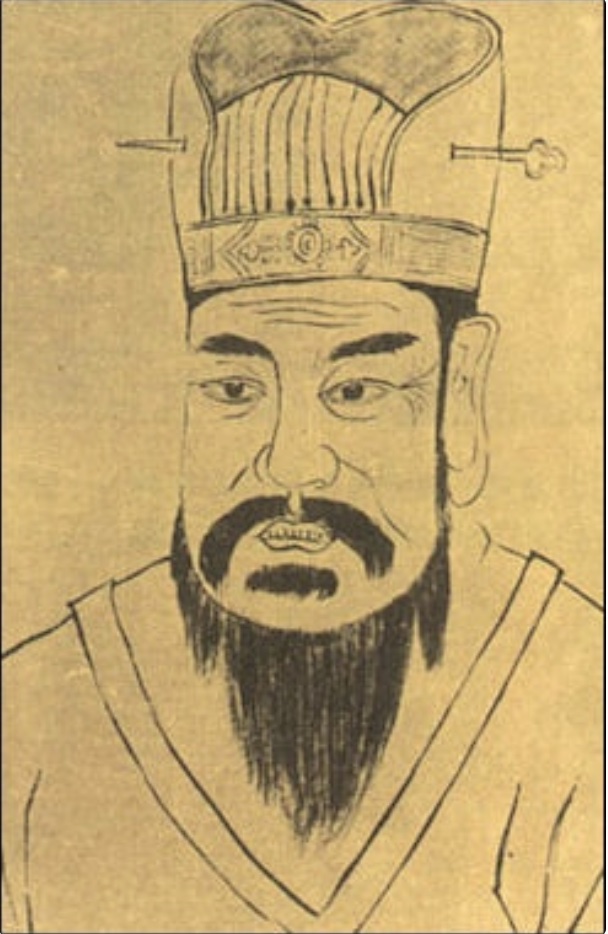Chinese History Quiz Two
1/46
There's no tags or description
Looks like no tags are added yet.
Name | Mastery | Learn | Test | Matching | Spaced |
|---|
No study sessions yet.
47 Terms
What is corvée service?
a system of compulsory, unpaid labor imposed by the state on peasants and commoners for public works, military service, or other government duties
Name a few features of Qin rule that were kept by the Han emperors.
Centralized Bureaucracy – The Han maintained the Qin system of a strong, centralized government with an emperor at the top, supported by a complex bureaucracy. The Qin’s administrative divisions (commanderies and counties) remained in place.
Legalist Influence – While the Han softened some of the harsh Legalist policies of the Qin, they still used aspects of Legalism, such as strict laws, standardization, and bureaucratic discipline, to maintain order.
Standardization – The Han retained Qin policies of standardizing weights, measures, currency, and writing to ensure unity across the empire.
Military Expansion and Border Defense – Like the Qin, the Han continued efforts to expand and defend China's frontiers, maintaining the Great Wall and using military campaigns to deal with nomadic threats, such as the Xiongnu.
Infrastructure Projects – The Han upheld the Qin’s focus on major state projects like road networks, canals, and irrigation systems to facilitate governance and economic development.
Merit-Based Bureaucracy – The Qin had begun a system where officials were appointed based on ability rather than aristocratic birth. The Han refined this system, later introducing Confucian examinations that laid the groundwork for the imperial civil service system.
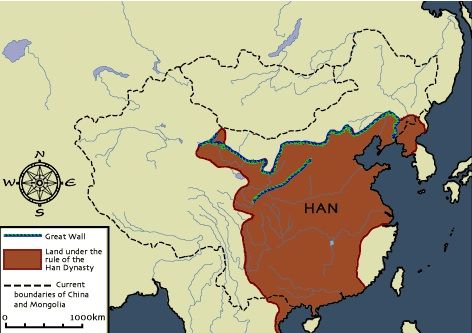
What changed in the Han administration?
Shift from Strict Legalism to Confucianism – The Qin ruled with harsh Legalist policies, but the Han blended Legalism with Confucianism, promoting moral governance and education.
Modification of the Centralized Bureaucracy – The Han retained the Qin’s centralized structure but allowed more local autonomy in the early Western Han period before recentralizing under Emperor Wu.
Development of the Civil Service System – Unlike the Qin’s reliance on loyalty-based appointments, the Han formalized a merit-based bureaucracy with Confucian education and training.
Economic Reforms and State Monopolies – The Han initially reduced taxes and corvée labor but later introduced state monopolies on key industries like salt and iron to boost revenue.
More Flexible Legal System – The Qin’s harsh punishments were softened under the Han, with fewer executions and more lenient laws.
Relations with Nomadic Tribes – The Qin focused on military suppression, while the Han initially used diplomacy and marriage alliances (heqin) before resuming military campaigns.
Expansion of Trade and the Silk Road – The Qin developed internal infrastructure, but the Han expanded external trade, establishing the Silk Road to connect China with Central Asia and beyond.
Owning land was very important in early imperial China. Give some reasons.
While some landowners were extremely wealthy, the majority of landholders owned small properties. Preserves wealth and can be passed down
Who served in the military when universal military service was abolished in the Han dynasty?
Professional Soldiers (Northern Frontier Garrisons) – The Han created a standing army of full-time, professional soldiers, especially to guard the northern frontier against the Xiongnu. Many of these soldiers were stationed in permanent border garrisons.
Mercenaries and Tribal Auxiliaries – The Han increasingly relied on non-Han tribal warriors (such as Xiongnu defectors and Qiang tribesmen), who were often given land or pay in exchange for military service.
Convicts and Penal Troops – Criminals could be sentenced to military service as punishment, often assigned to dangerous tasks or border defense.
Volunteer and Privately Recruited Troops – Wealthy landowners or officials sometimes raised their own private armies, particularly during times of internal conflict or rebellion.
Gentry and Scholar-Officers – While not a formal military class, some educated elites served in command positions or as strategists, particularly under Emperor Wu’s military expansion.
Retainers of Military Colonies (Tuntian System, 屯田制) – The Han established military-agricultural colonies, where soldiers and their families settled on frontier lands, both farming and defending the empire.
Describe the first emperor of the Han dynasty, Liu Bang. How is he portrayed? Was he an aristocrat?
the victorious rebel from peasant background. had served as as supervisor of 1000 households during the Qin making him well acquainted with Qin law while he attacked Qin for its brutality
The Han empire saw many changes under the reign of Han Emperor Wudi. Describe some of these changes.
Institutional reforms: confucianism was made his state ideology and Confusian scholars were entrusted, Nobility had to return ther fiefdoms which reduced cost of hosting them in capital, unlawful behavior would be punished, emperor was the absolute autocrat but kept the legalist ideas that allowed him to maintain control over political desisions, the imperial university to educate capable officers. Agriculture reforms: Construction of a series of canals that linked Chang’an with the Yellow River, an irrigation system that relieved stress on the dikes during floods, and walls were built with brick lining allowing for deeper walls. Economic reforms: salt and iron industries were turned into government-controlled monopolies in response to the financial burden of the expansion of trade into the frontiers of the west. The Silk Road: The expansion of roads throughout the Empire was an important improvement for shipment and transportation. Expansion of the Empire: The empire reached a vast territorial extension which would only be surpassed by the Manchurian Qing dynasty
What does the term peace-marriage (heqing) describe?
A diplomatic strategy where Han princesses or noblewomen were married to nomadic leaders (e.g., Xiongnu) to secure peace and alliances.
Describe the principles of "tribute" in Han China.
A diplomatic and trade framework where foreign states acknowledged Han superiority by offering gifts, in exchange for protection, titles, and trade privileges.
Who was Zhang Qian?
A Han dynasty diplomat and explorer sent by Emperor Wu (141–87 BCE) to form alliances with Central Asian states against the Xiongnu. Captured by the Xiongnu but later escaped, he provided valuable intelligence on trade routes, cultures, and geography, leading to the expansion of the Silk Road.
Please explain why the term 'Silk Road' might be misleading.
it implies a single road, but it was actually a network of interconnected trade routes, both overland and maritime, that facilitated the exchange of goods, ideas, and cultures across Asia, Europe, and Africa.
Be able to identify the Silk Road system on a map. What was the most dangerous part of the journey?
was crossing the Taklamakan Desert in Central Asia, due to extreme temperatures, lack of water, and unpredictable sandstorms, making it treacherous for travelers and caravans
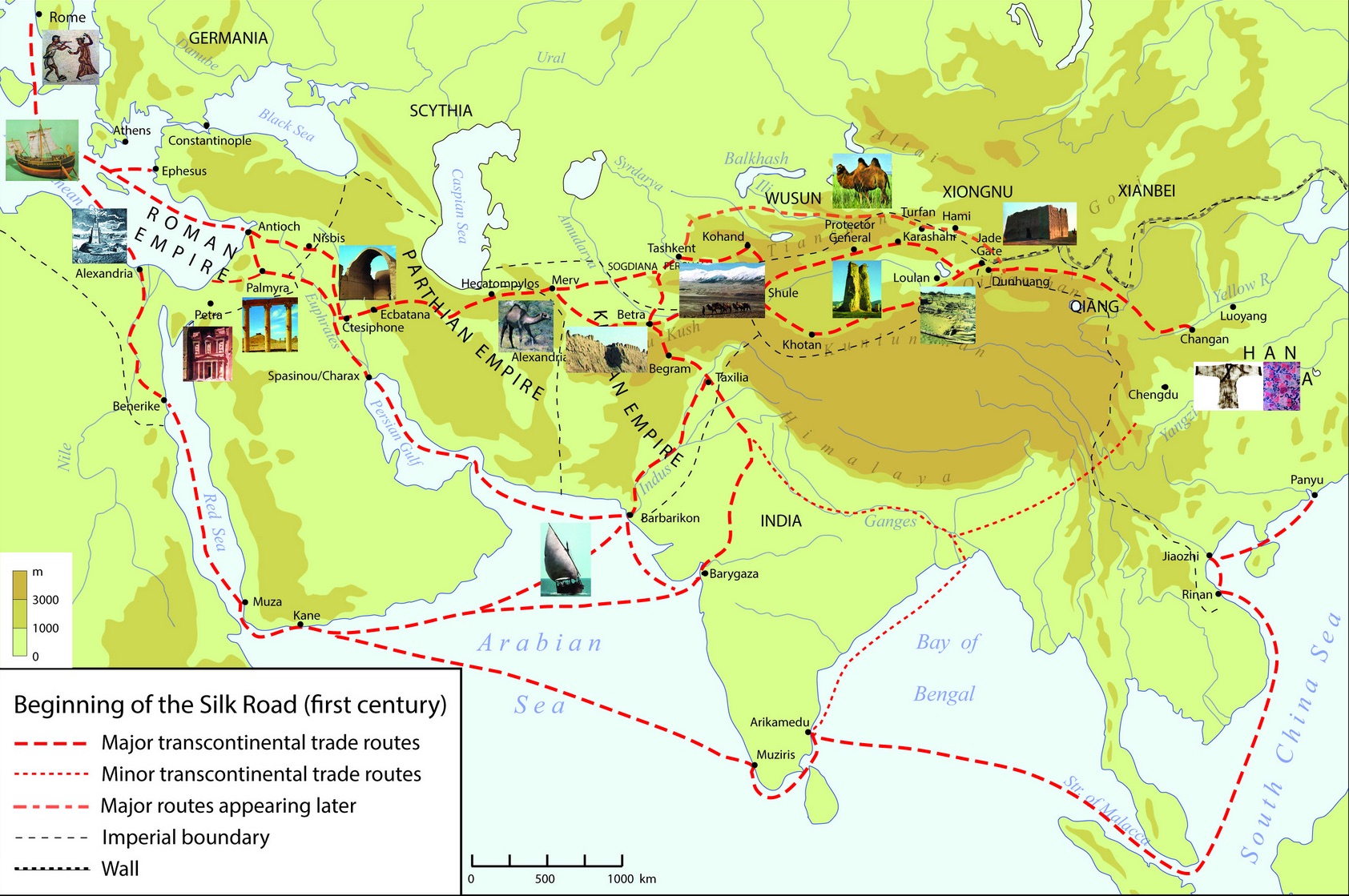
Since the Han Dynasty trade between the kingdoms of Central Asia and China brought novelties to China, while China exported goods. Name objects that were traded on the silk roads and explain which were imported to and exported by China.
Traded Goods on the Silk Road:
- Imported to China:
- Horses – From Central Asia, used for military and transport purposes.
- Glassware – From Rome, highly valued for luxury items.
- Wool – From Persia, used in textile production.
- Furs – From northern regions, used for clothing and trade.
- Religious Items – Buddhism, from India, deeply influenced Chinese culture.
- Exported by China:
- Silk – China’s most famous export, highly prized in the West.
- Porcelain – Fine ceramic ware, valued in Central Asia and Europe.
- Tea – First traded along the Silk Road, later becoming a staple export.
- Paper – Introduced to the West through the trade routes.
- Spices – Used in cooking and for medicinal purposes.
Imagine you were a local magistrate during the Han dynasty. Describe your job.
As a local magistrate during the Han Dynasty, my role would involve overseeing a county or district within the empire. My duties would include:
Enforcing laws – I would ensure the implementation of imperial laws and local regulations, including tax collection and managing disputes.
Managing local officials – I would supervise lower-ranking officials, such as clerks and tax collectors, to maintain order and ensure proper administration.
Overseeing justice – I would hear cases, resolve disputes, and ensure that punishments were fairly administered, often following Confucian principles of morality.
Tax collection and agricultural oversight – I would ensure that taxes were collected from local peasants, primarily based on agricultural production, and manage resources for state projects.
Military coordination – In times of trouble, I would also be responsible for organizing local defense, recruiting soldiers, and maintaining peace within my jurisdiction.
Who was Sima Qian?
'praise and blame' method. A Han historian and author of the Records of the Grand Historian (Shiji), a comprehensive history of China from the mythical origins to the Han Dynasty. His work laid the foundation for Chinese historiography, blending narrative history with biographical and philosophical insights.
Who was Ban Gu?
A Han historian and author of the Book of Han (Hanshu), which records the history of the Western Han Dynasty. He continued the work of Sima Qian and helped establish the official historiographical tradition in China. His work includes detailed accounts of the Han dynasty’s political, economic, and social structures.
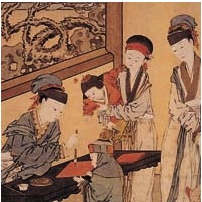
Who was Ban Zhao?
Ban Zhao completed the History of the Han Dynasty, which had been begun by her brother; a treatise on how a woman should behave and speak (modest, respectful & polite; abstain from gossip and vulgar language)
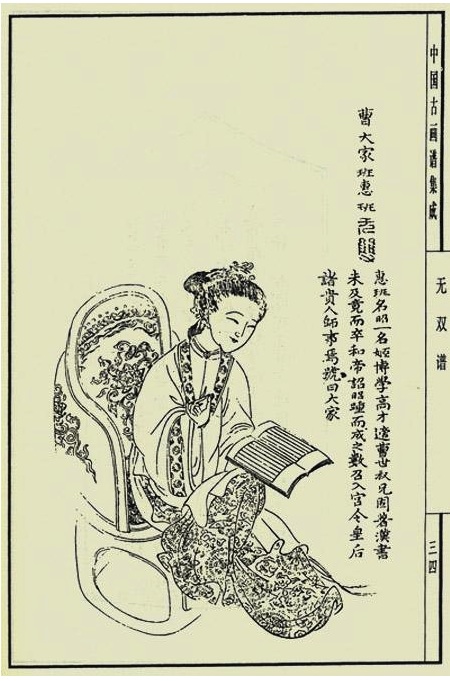
What does the 'principle of praise and blame' describe?
a Confucian concept used in governance, where rulers are encouraged to reward virtuous behavior (praise) and punish misconduct (blame). This principle aims to promote moral behavior and social harmony by holding officials and citizens accountable for their actions.
What is the Record of the Grand Historian (Shiji)?
is a foundational historical text of China. It covers the history of China from the mythical Yellow Emperor to the Han Dynasty, blending historical events with biographies, legends, and philosophical insights. It is considered one of the most influential works in Chinese historiography.
The structure of China's dynastic histories followed the pattern established by Sima Qian. Which of the following sections did he include as important parts of the dynastic annals: 1. Basic chronicles; 2. Tables of lineages and important events; 3. Treatises on rituals, music, sacrifices, and later bibliographies; 4. Genealogies of important clans ('Hereditary houses'); 5. Biographies of important persons, beginning with the founding emperor; 6. Balance sheets of the expenditures of court eunuchs; 7. Lists of punished villains and their burial places.
Sima Qian's Shiji (Records of the Grand Historian) set the structure for later Chinese dynastic histories, which followed a pattern that included the following sections:
Basic Chronicles – A detailed narrative of major events and key political developments during each dynasty.
Tables of Lineages and Important Events – Tables summarizing the succession of rulers and significant events.
Treatises on Rituals, Music, Sacrifices, and Later Bibliographies – The inclusion of philosophical, cultural, and governmental topics.
Genealogies of Important Clans ('Hereditary Houses') – Tracking the lineage of influential families.
Biographies of Important Persons, Beginning with the Founding Emperor – Including notable figures such as rulers, scholars, and military leaders.
Sima Qian did not include:
Balance Sheets of the Expenditures of Court Eunuchs (This was not a focus in his structure.)
Lists of Punished Villains and Their Burial Places (Not part of the structure in the Shiji.)
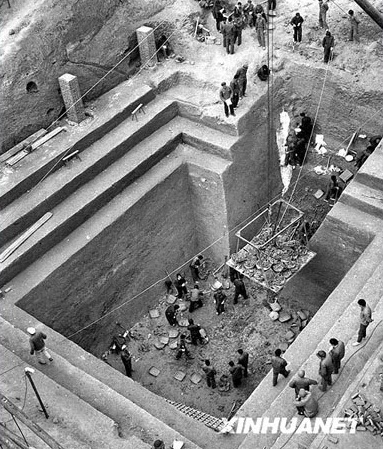
The tombs of Mawangdui are important 'material witnesses' of Han regional culture. Please describe what was learned from the excavation of the tomb of Lady Dai and her son.
Mummified Bodies – The well-preserved mummies of Lady Dai and her son offered a rare glimpse into Han burial practices, showcasing the use of elaborate embalming techniques.
Funerary Goods – A wealth of luxurious items was found, including silk garments, lacquerware, and wooden figurines, highlighting the importance of material culture and the role of the afterlife in Han society.
Textiles and Silk – The tomb contained finely crafted silk fabrics, providing evidence of Han textile technology and its significance in both everyday life and ceremonial practices.
Medicine and Health – Various medicinal items, such as herbal remedies and acupuncture tools, were discovered, offering insight into Han medicine and Lady Dai's health.
Art and Daily Life – Paintings and artifacts depicting daily life, along with representations of family and court, revealed cultural norms, family structures, and social hierarchy in Han China.
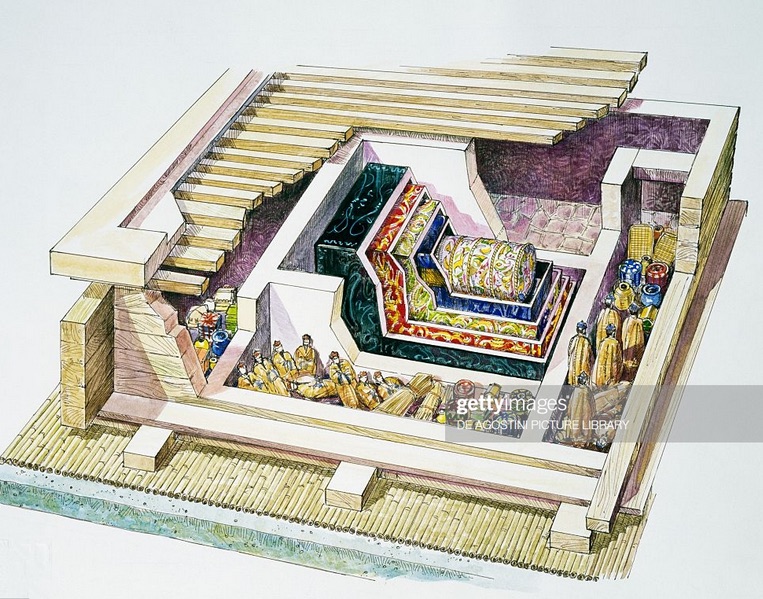
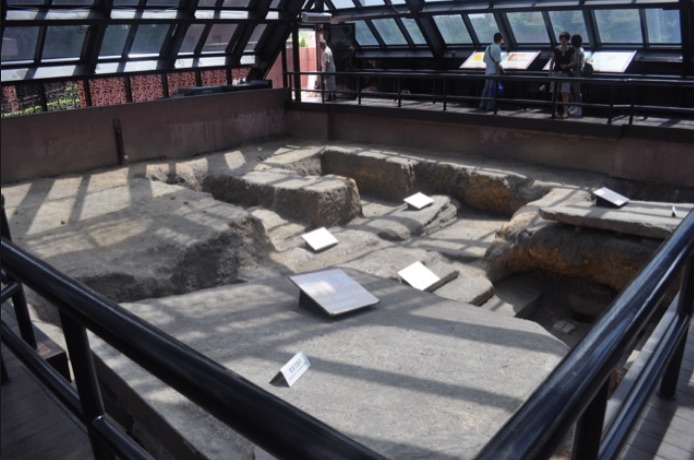
The tomb of King Zhao Mo's in Guangzhou also showed the importance of regional centers. Please explain in which ways King Zhao Mo's tomb reflects this power. The Zhao clan was not always in loyal connection with the Han imperial house. When was their territory integrated into the Han empire?
Rich Funerary Goods – The tomb contained a vast array of luxurious items, including gold, silver, lacquerware, and fine textiles, showcasing the wealth and status of the Zhao clan and their regional influence. This wealth reflects the power they held in the southern region, not just as rulers but as major players in trade and cultural exchange.
Distinctive Artifacts – The tomb's contents included artifacts blending Chinese and local southern influences, highlighting the Zhao clan's role in maintaining a distinct cultural identity within the broader Han Empire.
Military Symbols – Items like weapons and military paraphernalia in the tomb point to the Zhao clan’s military strength and their ability to maintain a degree of autonomy and power in the region.
Political Autonomy – Despite their connection to the Han Empire, the Zhao clan often maintained independence and, at times, was not fully loyal to the Han court. This is evident in the tomb's grandeur and its reflection of local dominance.
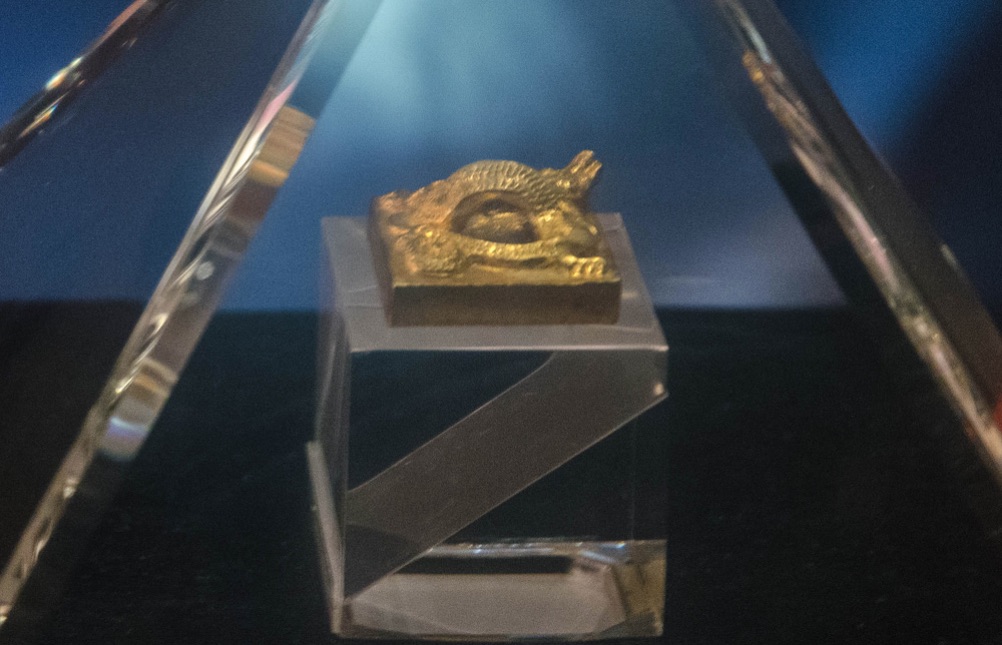
Please describe the advent of Buddhism in China. Where did the religion originate? When did it come to China? Which path did it take? Who brought Buddhism to China?
Buddhism originated in India during the 5th–4th century BCE with the teachings of Siddhartha Gautama (the Buddha). It spread to China during the Han Dynasty, likely in the 1st century CE, via the Silk Road. Traders, monks, and diplomats from Central Asia played key roles in its transmission. Missionaries such as Lokakṣema, a Kushan monk, translated Buddhist texts into Chinese. Over time, Buddhism adapted to Chinese culture, incorporating Daoist and Confucian elements.
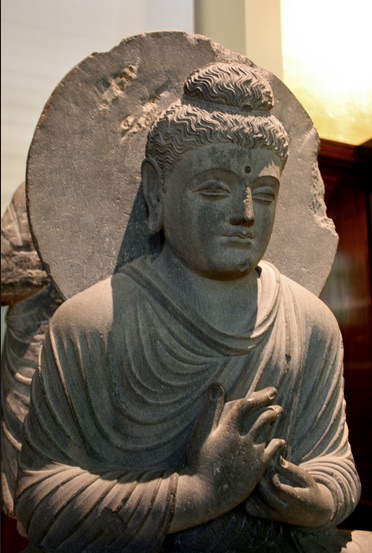
What are the most important principles of Buddhism that made the teaching acceptable in China? Which similarities to ethical or religious concepts of other systems of thought in China are obvious?
Karma & Rebirth – Aligned with Daoist natural cycles.
Compassion & Morality – Similar to Confucian ren (humaneness).
Monastic Life & Self-Cultivation – Echoed Daoist self-discipline.
Filial Piety – Adapted to honor ancestors, easing Confucian concerns.
Escape from Suffering – Resonated with Daoist detachment (wu wei).
Which principles appeared foreign to those Chinese persons who were interested in the new religion? Why?
Monasticism & Celibacy – Conflicted with Confucian ideals of family duty and filial piety.
Reincarnation & Karma – Differed from traditional ancestor worship, which emphasized lineage continuity.
Salvation Through Withdrawal – The Buddhist focus on monastic life and detachment clashed with Confucian values of social responsibility.
Sutras & Foreign Language – Early Buddhist texts were in Sanskrit, making them inaccessible and requiring adaptation into Chinese thought.
Emphasis on Suffering – The Buddhist view of life as suffering (dukkha) contrasted with Confucian and Daoist ideals of harmony.
Who was An Shigao?
An Shigao (c. 148–180 CE) was a Parthian prince-turned-monk who became one of the first Buddhist missionaries to China. He arrived in the Han capital, Luoyang, and translated many early Buddhist texts from Sanskrit into Chinese. His work focused on meditation and ethics, laying the foundation for Chinese Buddhist thought. An Shigao played a crucial role in introducing Buddhism to China and adapting it to local cultural and philosophical traditions.
Buddhist teachings had to be translated from Sanskrit to Chinese. How did the translators achieve an understanding of unfamiliar concepts among the new adepts in China?
Daoist Terminology – They adapted Daoist terms to explain Buddhist ideas (e.g., wu wei 無為 for Nirvana).
Paraphrasing & Interpretation – Instead of direct translation, they reworded texts to align with Chinese thought.
New Vocabulary – Created new Chinese terms for Buddhist concepts, like karma (業, yè) and nirvana (涅槃, nièpán).
Commentaries & Explanations – Added detailed commentaries to clarify difficult ideas.
Translation Teams – Groups of Chinese scholars and foreign monks worked together for accuracy.
Model of the gate tower; the Han dynasty funerary object
objects in funerals and burials to provide for the deceased in the afterlife. These tomb figurines, called mingqi (明器), represented daily life, status, and wealth, ensuring the dead had everything they needed, from servants and animals to houses and granaries. This practice reflected Confucian filial piety and beliefs in an afterlife where the dead continued to require material goods.
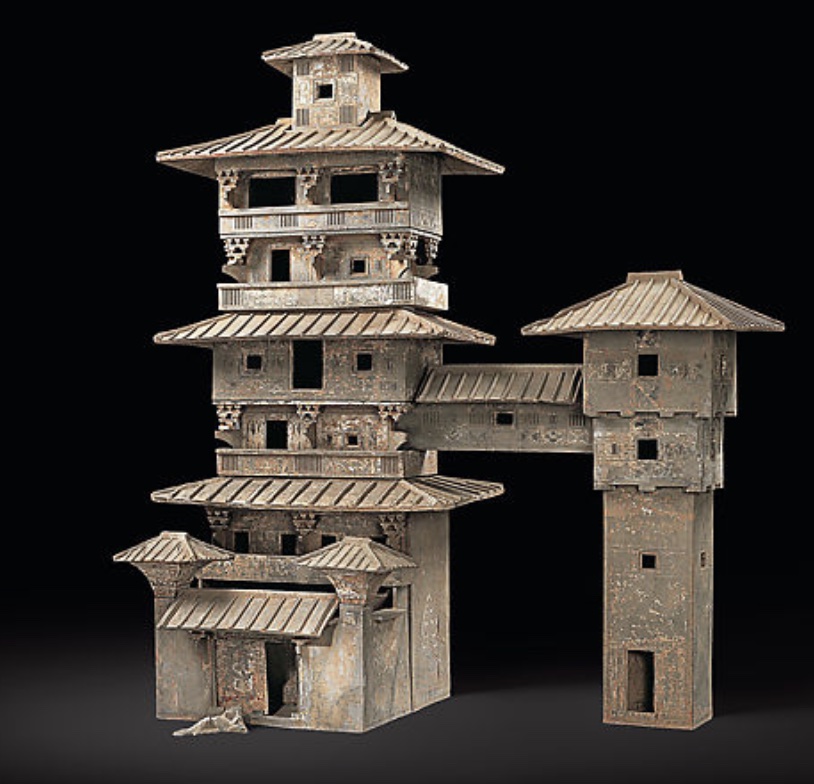
innovations in agriculture
water-powered mills (picture)

animal draw plow with moldboard
animal draw plow with moldboard

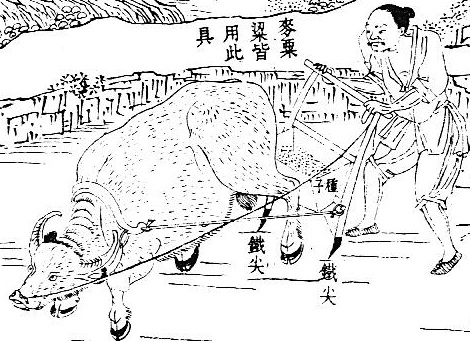
drawing of farmer working with a seed drill
seed drill
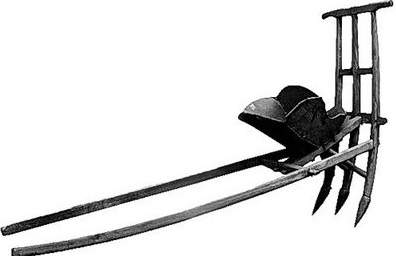
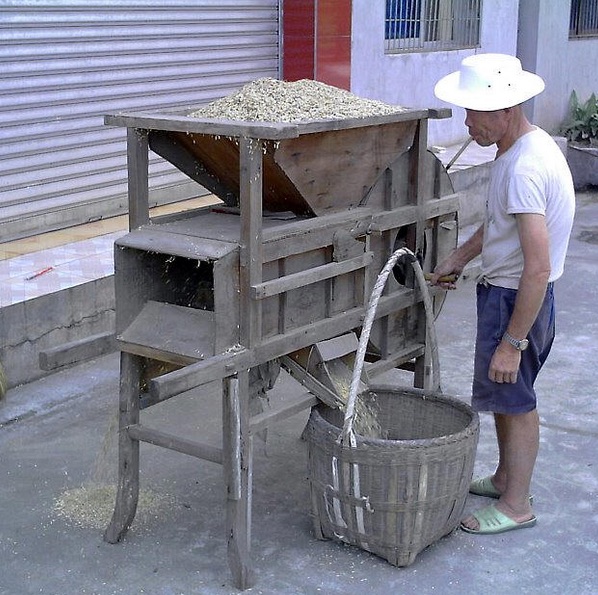
winnowing machine
with crack to sort grain from chaff
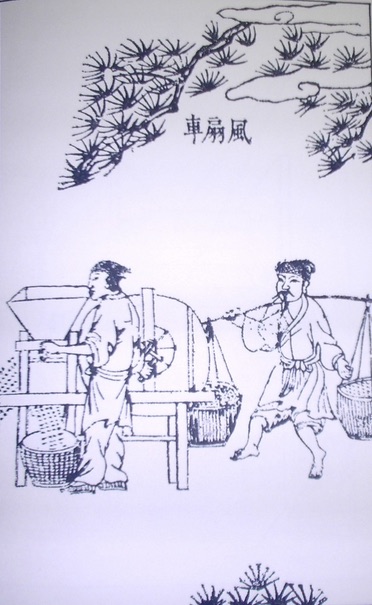
Water-powered bellow for casting agricultural tools from Wang Zhen's Nongshu (Book of Agriculture, publ. in 1313)
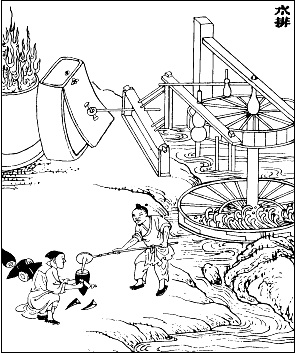
Navigation: ships with watertight compartments, multiple masts, and stern-post rudders
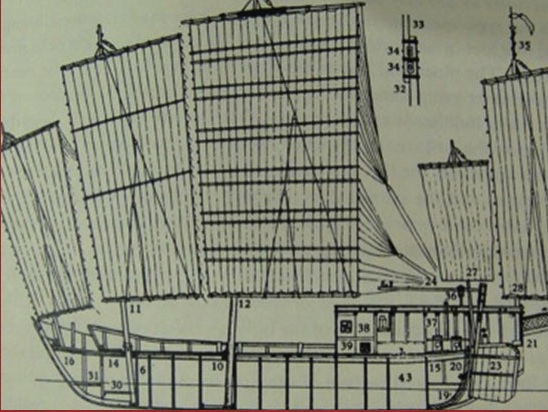
Magnetic compass: orientation at sea during bad weather conditions when stars invisible
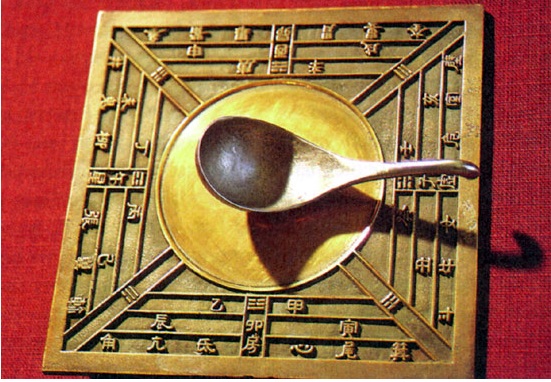
Wheelbarrow (with sail) = transportation of persons and goods
(Somewhat crude) replica of Zhuge Liang's (181-234) 'wooden ox': wheelbarrow drawn by an ox with the supply for four soldiers for one month
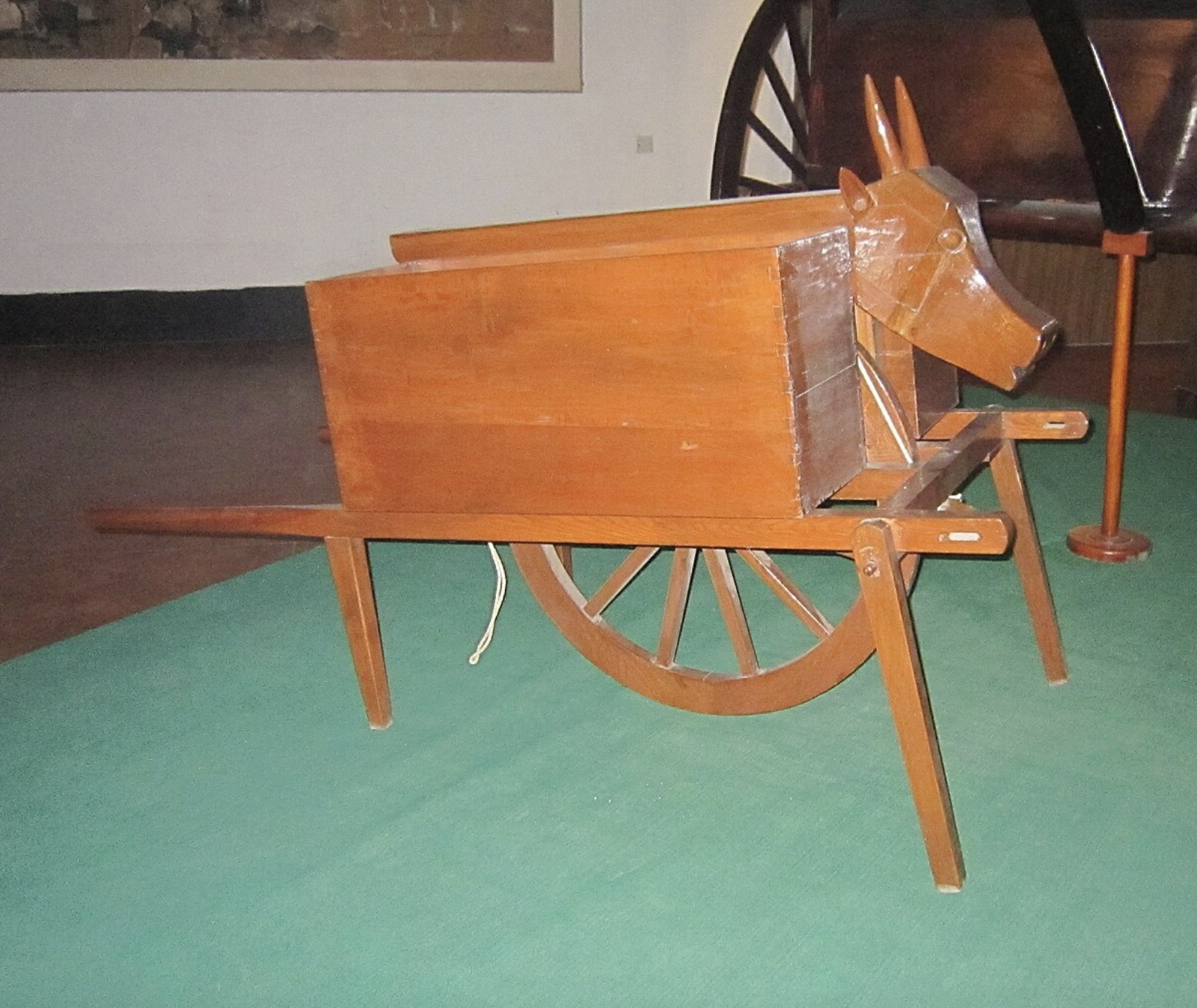
Who were the Xiongnu
The first great nomadic empire in Asia, an association of many different tribes of nomadic people's of ancient Central Asia. The name came to be used for people of Turkic, Mongol, Tocharian, and Persian origin.
The Xiongnu originally lived in the area that today forms the Inner Mongolia Autonomous Region.
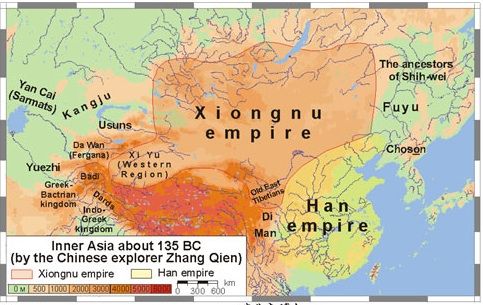
note for quiz
The Reign of Han Emperor Wu lecture lacks pictures
Replica of Lady Dais inner coffin
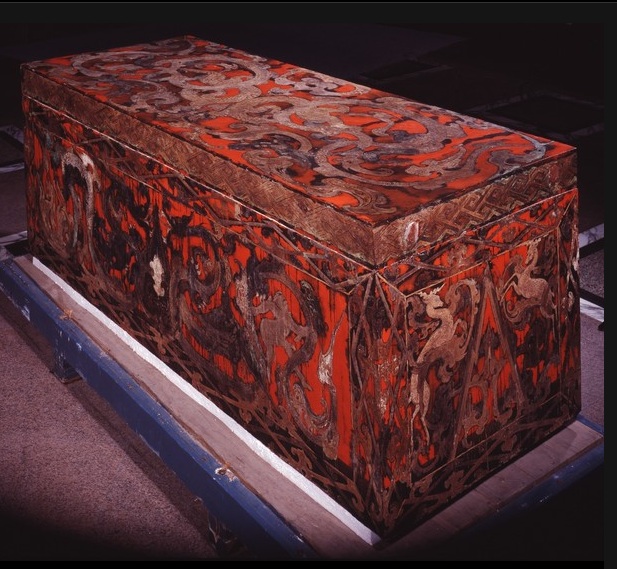
Lower section of Lady Dai’s soul banner
Lower section of the banner: offerings and ceremonies devoted to Lady Dai's body soul (po 魄) by mourners.
Deity of the earth carries the foundation of the tomb
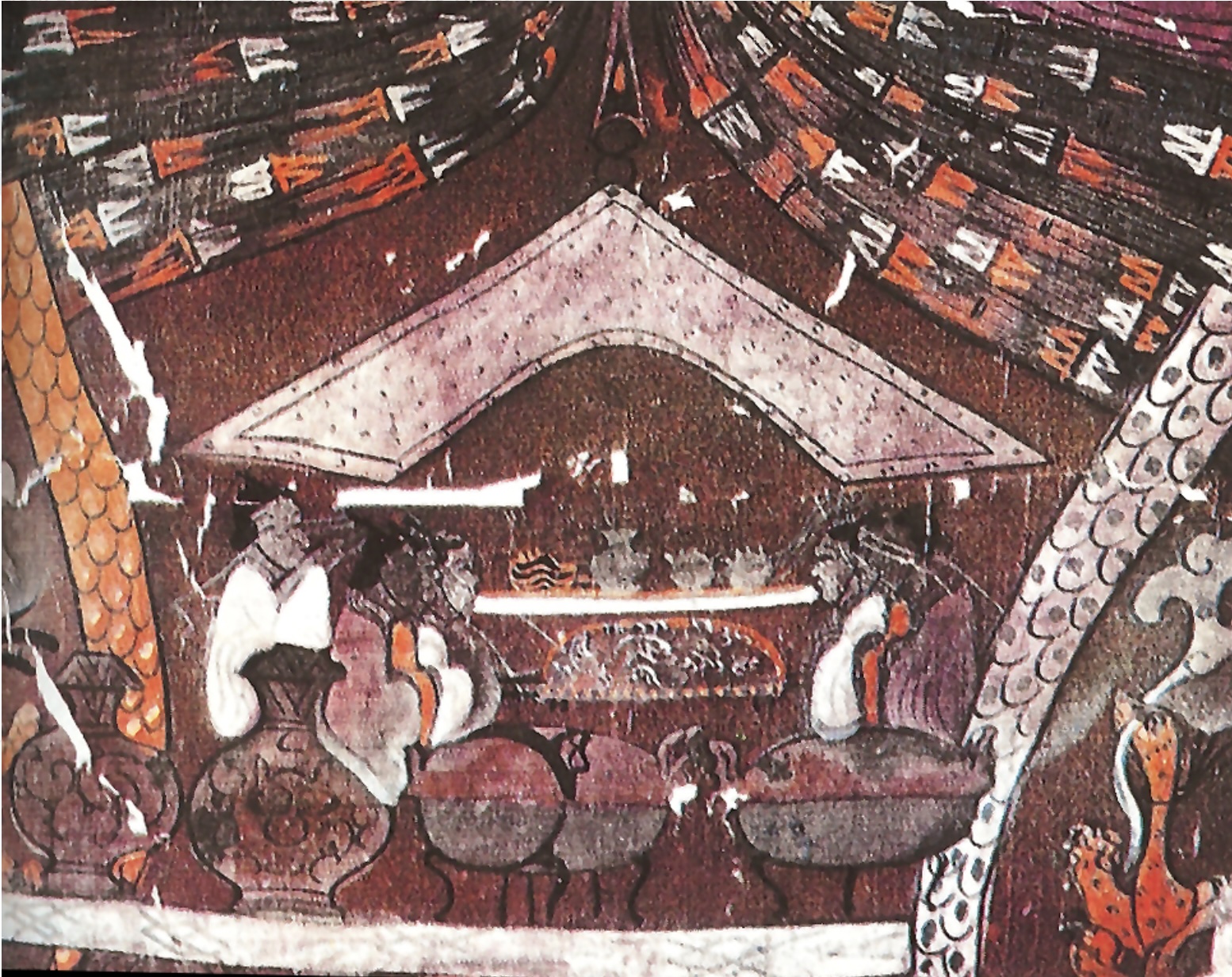
Central section of Lady Dai’s soal banner
Ascension and rejuvenation after death
Lady Dai standing upright while leaning on a cane, female attendants (standing behind her) and servants sitting or kneeling in front of her
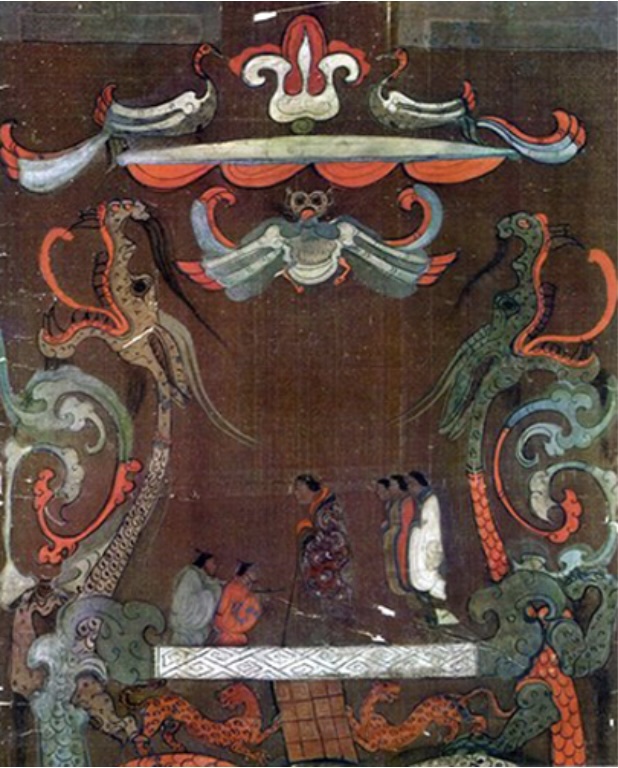
Upper section of Lady Dai’s soul banner
realm of the immortals: two guardians = deities of destiny hold records of the life span of Lady Dai;
the moon is shown with the rabbit (usually shown as pounding the elixir of immortality) jumping over a toad
the sun is depicted with the raven, usually depicted with three legs and referred to as the 'three legged bird' (even though here the raven has but two legs)
The celestial scene of the immortals has been interpreted as showing Archer Yi (who shot down nine suns -which suddenly appeared in addition to the single sun- and thus prevented the earth from being destroyed) on the right side.
On the left side his wife Chang'e flees to the crescent moon with the elixir of immortality, the reward given to Archer Yi for saving the world.
Chang'e was transformed into a toad as a punishment for stealing the elixir of immortality. Here the rabbit (which is often shown pounding the ingredients for the elixir of immortality) jumps over the toads head.
The deitiy at the top whose body ends in a snake has been interpreted as Nüwa.
Topographical map from the Tomb of Lady Dai's son (tomb no. 3) showing the area of the Han state of Changsha and the kingdom of Nanyue
tomb of Lady Dai's son (military official):
- three maps: 1. area of the tomb; 2. area between the territory of the King of Changsha and the territory of the people of the Southern Yue. (Southern Yue attacked by the Han in 181 B.C.E.; Han successfully expanded their territory to the south and southwest).
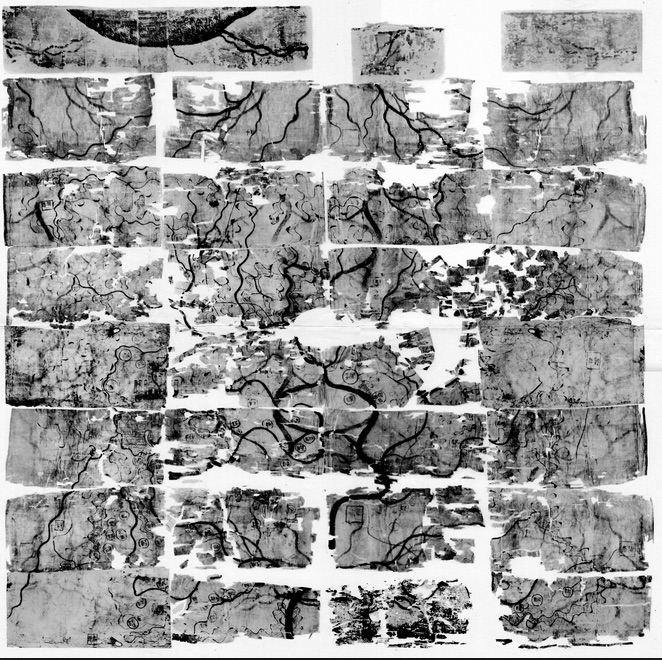
Text on law: obligations of the ruler
punishments have to be balanced with rewards, the ruler may not indulge in consumption, and wars may only be started for a just cause.
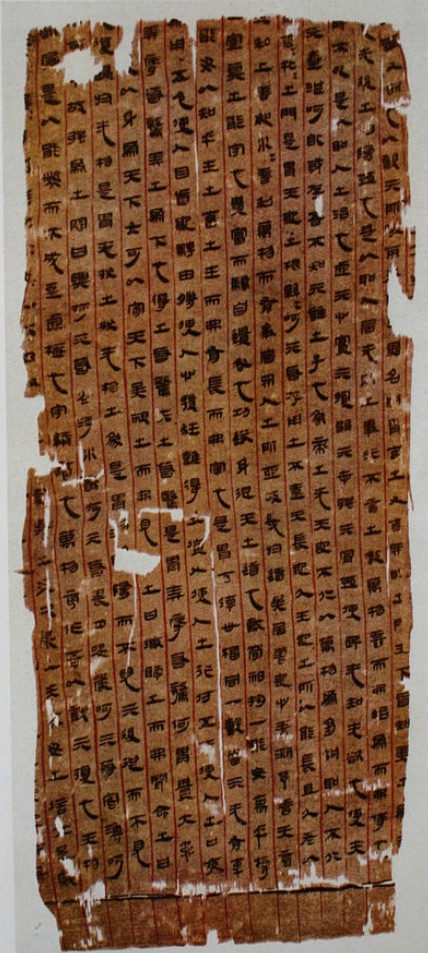
King Zhao Mo’s jade suit
important because it reflected the Han Dynasty belief in the preservation of the body for immortality. Made of over 2,000 jade plaques sewn together with gold thread, the suit demonstrated the wealth and status of the Nanyue king while also showcasing advanced craftsmanship. It also provided insight into the cultural and political connections between the Nanyue Kingdom and the Han Dynasty, as jade burial suits were typically reserved for Han elites.
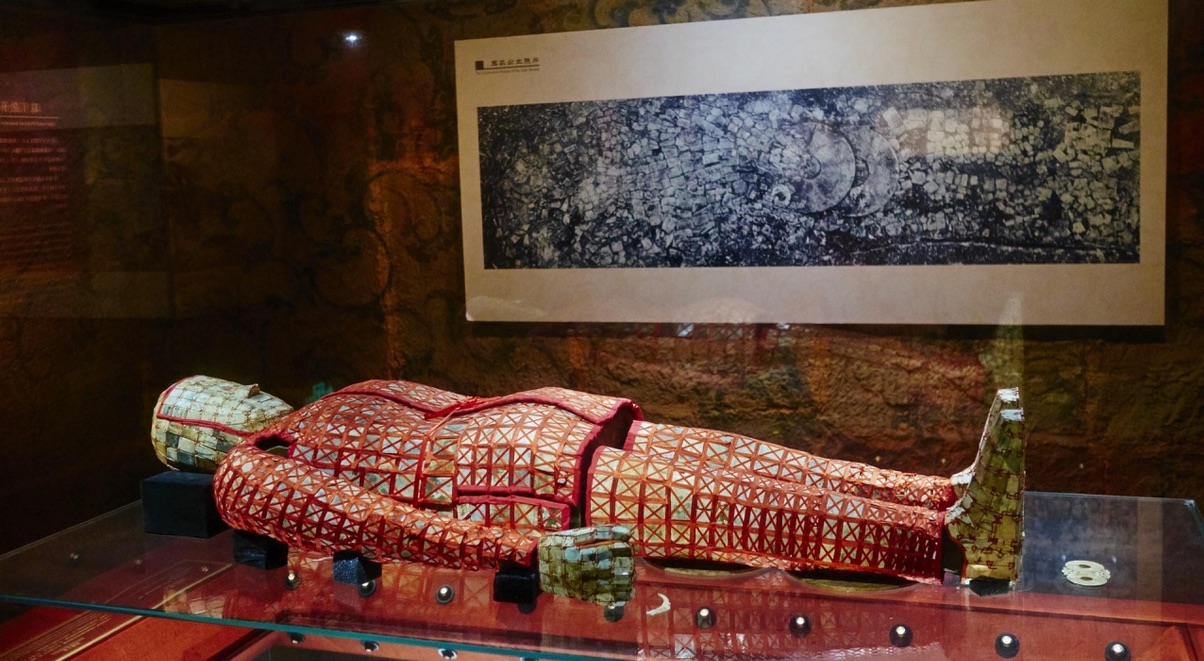
Statue of Kumārajīva in front of the Kizil Caves in Kuqa, Xinjiang province, China

Wang Mang: Xin Dynasty
Wang Mang was related to Han empress Wang Zhengjun, wife of Han emperor Yuan;
had few privileges; had a position in the administration and moved up the ranks to become
a (lower ranking) commander of the Imperial Guard,
then -with the help of an uncle- a marquis,
a minister without special tasks,
and finally a commander of an army (ca. 20,000 soldiers);
he gained the reputation of being a disciplined administrator
